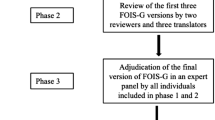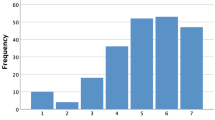Abstract
Purpose
Post-stroke dysphagia (PSD) is the most common type of dysphagia. Stroke patients with sustained dysphagia have poorer outcomes. The severity of PSD is assessed using miscellaneous scales with unknown consistencies. We aim to investigate the consistencies among miscellaneous scales, which could aid in the assessment of PSD.
Methods
A total of 49 PSD patients were enrolled. Functional Oral Intake Scale (FOIS), Dysphagia Severity Scale (DSS), Ohkuma Questionnaire, Eating Assessment Tool-10, and Repetitive Saliva Swallowing Test were performed. FOIS was performed by physicians, and DSS was conducted by both the physicians and nurses; the physicians used either videofluoroscopy (VF) or videoendoscopy (VE) for evaluation; while, the nurses assessed PSD by observation and subjective judgment.
Results
When using VF (VF-DSS and VF-FOIS) as the gold standard for the evaluation, VE-FOIS (κ = 0.625, 95% CI 0.300–0.950, p < 0.001) has a substantial agreement with VF-FOIS, and VE-DSS (κ = 0.381, 95% CI 0.127–0.636, p = 0.007) has a fair agreement with VF-DSS. The weighted kappa of FOIS to DSS in VE (weighted κ = 0.577, 95% CI 0.414–0.740, p < 0.001) is not lower than that in VF (weighted kappa = 0.249, 95% CI 0.136–0.362, p < 0.001).
Conclusion
For both DSS and FOIS, only VE has a statistically significant agreement with VF. Though VF has been viewed as the traditional gold standard of dysphagia screening, it has the limitations of being invasive and equipment dependent. For PSD, VE could be considered as a substitution when VF is not available or suitable.
Similar content being viewed by others
Availability of data and materials
The data that support the findings of this study are not openly available due to reasons of sensitivity and are available from the corresponding author upon reasonable request. Data are located in controlled access data storage at Kaohsiung Municipal Siaogang Hospital.
References
US Department of Health and Human Services. Archived EPC Evidence Reports. 1999. Agency for Healthcare Research and Quality. Diagnosis and treatment of swallowing disorders (dysphagia) in acute-care stroke patients. Evidence report/technology assessment (Summary). pp. 1–6
Sura L, Madhavan A, Carnaby G, Crary MA (2012) Dysphagia in the elderly: management and nutritional considerations. Clin Interv Aging 7:287–298. https://doi.org/10.2147/CIA.S23404
Khan A, Carmona R, Traube M (2014) Dysphagia in the elderly. Clin Geriatr Med 30(1):43–53. https://doi.org/10.1016/j.cger.2013.10.009
Kumar S, Selim MH, Caplan LR (2010) Medical complications after stroke. Lancet Neurol 9(1):105–118. https://doi.org/10.1016/S1474-4422(09)70266-2
Wang Z, Song WQ, Wang L (2017) Application of noninvasive brain stimulation for post-stroke dysphagia rehabilitation. Kaohsiung J Med Sci 33(2):55–61. https://doi.org/10.1016/j.kjms.2016.11.007
Cohen DL, Roffe C, Beavan J et al (2016) Post-stroke dysphagia: a review and design considerations for future trials. Int J Stroke 11(4):399–411. https://doi.org/10.1177/1747493016639057
Wirth R, Dziewas R, Beck AM et al (2016) Oropharyngeal dysphagia in older persons—from pathophysiology to adequate intervention: a review and summary of an international expert meeting. Clin Interv Aging 23(11):189–208. https://doi.org/10.2147/CIA.S97481
Lowery S (2001) Assessment and measurement tools used in the evaluation of swallowing. Curr Opin Otolaryngol Head Neck Surg 9:134–138. https://doi.org/10.1097/00020840-200106000-00003
Langmore SE, Schatz K, Olson N (1991) Endoscopic and videofluoroscopic evaluations of swallowing and aspiration. Ann Otol Rhinol Laryngol 100(8):678–681. https://doi.org/10.1177/000348949110000815
Ohkuma RFI, Kojima C, Hojo K, Takehara I, Motohashi Y (2002) Development of a questionnaire to screen dysphagia. Jpn J Dysphagia Rehabilit 6:3–8
Landis JR, Koch GG (1977) The measurement of observer agreement for categorical data. Biometrics 33(1):159–174
O’Horo JC, Rogus-Pulia N, Garcia-Arguello L, Robbins J, Safdar N (2015) Bedside diagnosis of dysphagia: a systematic review. J Hosp Med 10(4):256–265. https://doi.org/10.1002/jhm.2313
Wilmskoetter J, Bonilha H, Hong I, Hazelwood RJ, Martin-Harris B, Velozo C (2019) Construct validity of the Eating Assessment Tool (EAT-10). Disabil Rehabil 41(5):549–559. https://doi.org/10.1080/09638288.2017.1398787
Zhou H, Zhu Y, Zhang X (2017) Validation of the Chinese version of the Functional Oral Intake Scale (FOIS) score in the assessment of acute stroke patients with dysphagia. Stud Health Technol Inform 245:1195–1199
Nishimura K, Kagaya H, Shibata S et al (2015) Accuracy of Dysphagia Severity Scale rating without using videoendoscopic evaluation of swallowing. Jpn J Compr Rehabil Sci 6:124–128. https://doi.org/10.11336/jjcrs.6.124
Kawashima K, Motohashi Y, Fujishima I (2004) Prevalence of dysphagia among community-dwelling elderly individuals as estimated using a questionnaire for dysphagia screening. Dysphagia 19(4):266–271. https://doi.org/10.1007/s00455-004-0013-6
Persson E, Wårdh I, Östberg P (2019) Repetitive saliva swallowing test: norms, clinical relevance and the impact of saliva secretion. Dysphagia 34(2):271–278. https://doi.org/10.1007/s00455-018-9937-0
Boaden E, Burnell J, Hives L et al (2021) Screening for aspiration risk associated with dysphagia in acute stroke. Cochrane Database Syst Rev 10(10):CD012679. https://doi.org/10.1002/14651858.CD012679.pub2
Wu CH, Hsiao TY, Chen JC, Chang YC, Lee SY (1997) Evaluation of swallowing safety with fiberoptic endoscope: comparison with videofluoroscopic technique. Laryngoscope 107(3):396–401. https://doi.org/10.1097/00005537-199703000-00023
Giraldo-Cadavid LF, Leal-Leaño LR, Leon-Basantes GA, Bastidas AR, Garcia R, Ovalle S, Abondano-Garavito JE (2017) Accuracy of endoscopic and videofluoroscopic evaluations of swallowing for oropharyngeal dysphagia. Laryngoscope 127(9):2002–2010. https://doi.org/10.1002/lary.26419
Yoon JA, Kim SH, Jang MH, Kim SD, Shin YB (2019) Correlations between aspiration and pharyngeal residue scale scores for fiberoptic endoscopic evaluation and videofluoroscopy. Yonsei Med J 60(12):1181–1186. https://doi.org/10.3349/ymj.2019.60.12.1181
Helliwell K, Hughes VJ, Bennion CM, Manning-Stanley A (2023) The use of videofluoroscopy (VFS) and fibreoptic endoscopic evaluation of swallowing (FEES) in the investigation of oropharyngeal dysphagia in stroke patients: a narrative review. Radiography (Lond) 29(2):284–290. https://doi.org/10.1016/j.radi.2022.12.007
Tutor JD, Gosa MM (2012) Dysphagia and aspiration in children. Pediatr Pulmonol 47(4):321–337. https://doi.org/10.1002/ppul.21576
Acknowledgements
This work was supported partially by the grants from the Kaohsiung Municipal Siaogang Hospital (KMSH S-108-08) and from the Ministry of Science and Technology (MOST 108-2218-E010-005, MOST 109-2224-E010-001, MOST-110-2221-E-008-048).
Funding
This research did not receive any funding from agencies in the public, commercial, or not-for-profit sectors.
Author information
Authors and Affiliations
Corresponding author
Ethics declarations
Conflict of interest
The authors have no conflicts of interest to disclose.
Additional information
Publisher's Note
Springer Nature remains neutral with regard to jurisdictional claims in published maps and institutional affiliations.
Supplementary Information
Below is the link to the electronic supplementary material.
Rights and permissions
Springer Nature or its licensor (e.g. a society or other partner) holds exclusive rights to this article under a publishing agreement with the author(s) or other rightsholder(s); author self-archiving of the accepted manuscript version of this article is solely governed by the terms of such publishing agreement and applicable law.
About this article
Cite this article
Chen, WC., Lin, CW., Wu, MN. et al. Consistencies among miscellaneous scales for evaluation of post-stroke dysphagia. Eur Arch Otorhinolaryngol 280, 4561–4567 (2023). https://doi.org/10.1007/s00405-023-08101-x
Received:
Accepted:
Published:
Issue Date:
DOI: https://doi.org/10.1007/s00405-023-08101-x




